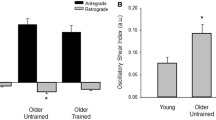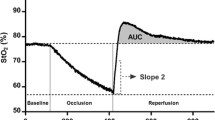Abstract
Introduction
Retrograde shear causes endothelial damage and is pro-atherogenic. The purpose of our study was to examine the impact of vascular remodeling from habitual exercise training on acute changes in retrograde shear and microvascular oxygenation (SMO2) induced via 30 min of external compression.
Methods
Participants included 11 exercise trained (ET) men (Division I track athletes; age 20 ± 3 years) and 18 recreationally active (RA) men (age 23 ± 5 years). Near-infrared spectroscopy (NIRS) was used to measure vastus medialis SMO2. Doppler-ultrasound was used to assess SFA intima-media thickness, diameter and flow velocity to derive retrograde shear. Vascular measures were made at baseline (BASELINE), during a sham condition (calf compression to 5 mmHg, SHAM) and during the experimental condition (calf compression to 60 mmHg, EXP).
Results
Compared to RA, ET had larger SFA diameters (0.66 ± 0.06 vs 0.58 ± 0.06 cm, p < 0.05) and lower SFA IMT (0.33 ± 0.03 vs 0.36 ± 0.07 mm, p < 0.05). Retrograde shear increased similarly in both groups during EXP (p < 0.05) but ET men had lower overall retrograde shear during the conditions (BASELINE 75.8 ± 26.8 vs EXP 88.2 ± 16.9 s−1) compared to RA men (BASELINE 84.4 ± 23.3 vs EXP 106.4 ± 19.6 s−1p < 0.05). There was a similar increase in SMO2 from BASELINE to SHAM (ET + 8.1 ± 4.8 vs RA + 6.4 ± 9.7%) and BASELINE to EXP (ET + 8.7 ± 6.4 vs RA + 7.1 ± 9.0%) in both groups.
Conclusion
Beneficial vascular remodeling in ET men is associated with lower retrograde shear during external compression. Acute increases in retrograde shear with external compression do not detrimentally impact microvascular oxygenation.


Similar content being viewed by others
Abbreviations
- BMI:
-
Body mass index
- DBP:
-
Diastolic blood pressure
- ET:
-
Exercise-trained
- HR:
-
Heart rate
- IPAQ:
-
International Physical Activity Questionnaire
- IMT:
-
Intima-media thickness
- SMO2 :
-
Muscle oxygen saturation
- NIRS:
-
Near-infrared spectroscopy
- PWV:
-
Pulse wave velocity
- RA:
-
Recreationally active
- SV:
-
Stroke volume
- SFA:
-
Superficial femoral artery
- SBP:
-
Systolic blood pressure
References
Augustine JA, Lefferts WK, Dowthwaite JN, Brann LS, Brutsaert TD, Heffernan KS (2016) Subclinical atherosclerotic risk in endurance-trained premenopausal amenorrheic women. Atherosclerosis 244:157–164
Bell PL, Kelley ET, McCoy SM, Credeur DP (2017) Influence of aerobic fitness on vasoreactivity in young men. Eur J Appl Physiol 117:2075–2083
Breton-Romero R, Wang N, Palmisano J, Larson MG, Vasan RS, Mitchell GF, Benjamin EJ, Vita JA, Hamburg NM (2016) Cross-sectional associations of flow reversal, vascular function, and arterial stiffness in the framingham heart study. Arterioscler Thromb Vasc Biol 36:2452–2459
Casey DP, Padilla J, Joyner MJ (2012) Alpha-adrenergic vasoconstriction contributes to the age-related increase in conduit artery retrograde and oscillatory shear. Hypertension (Dallas, Tex: 1979) 60:1016–1022
Casey DP, Schneider AC, Ueda K (2016) Influence of chronic endurance exercise training on conduit artery retrograde and oscillatory shear in older adults. Eur J Appl Physiol 116:1931–1940
Crum EM, O'Connor WJ, Van Loo L, Valckx M, Stannard SR (2017) Validity and reliability of the Moxy oxygen monitor during incremental cycling exercise. Eur J Sport Sci 17:1037–1043
de Zepetnek JO, Jermey TL, MacDonald MJ (2014) Superficial femoral artery endothelial responses to a short-term altered shear rate intervention in healthy men. PLoS ONE 9:e113407
de Zepetnek JO, Ditor DS, Au JS, MacDonald MJ (2015) Impact of shear rate pattern on upper and lower limb conduit artery endothelial function in both spinal cord-injured and able-bodied men. Exp Physiol 100:1107–1117
Dinenno FA, Jones PP, Seals DR, Tanaka H (2000) Age-associated arterial wall thickening is related to elevations in sympathetic activity in healthy humans. Am J Physiol Heart Circ Physiol 278:H1205–1210
Dinenno FA, Tanaka H, Monahan KD, Clevenger CM, Eskurza I, DeSouza CA, Seals DR (2001) Regular endurance exercise induces expansive arterial remodelling in the trained limbs of healthy men. J Physiol 534:287–295
Feistritzer HJ, Reinstadler SJ, Klug G, Kremser C, Seidner B, Esterhammer R, Schocke MF, Franz WM, Metzler B (2015) Comparison of an oscillometric method with cardiac magnetic resonance for the analysis of aortic pulse wave velocity. PLoS ONE 10:e0116862
Freire CM, Ribeiro AL, Barbosa FB, Nogueira AL, Almeida MC, de Barbosa MM, Lana AM, de Silva AC, Ribeiro-Oliveira A (2009) Comparison between automated and manual measurements of carotid intima-media thickness in clinical practice. Vasc Health Risk Manag 5:811–817
Green DJ, Spence A, Rowley N, Thijssen DH, Naylor LH (2012) Vascular adaptation in athletes: is there an 'athlete's artery'? Exp Physiol 97:295–304
Halliwill JR, Minson CT (2010) Retrograde shear: backwards into the future? Am J Physiol Heart Circ Physiol 298:H1126–1127
Hashimoto J, Ito S (2010) Pulse pressure amplification, arterial stiffness, and peripheral wave reflection determine pulsatile flow waveform of the femoral artery. Hypertension (Dallas, Tex: 1979) 56:926–933
Heffernan KS, Lefferts WK, Kasprowicz AG, Tarzia BJ, Thijssen DH, Brutsaert TD (2013) Manipulation of arterial stiffness, wave reflections, and retrograde shear rate in the femoral artery using lower limb external compression. Physiol Rep 1:e00022
Helmerhorst HJ, Brage S, Warren J, Besson H, Ekelund U (2012) A systematic review of reliability and objective criterion-related validity of physical activity questionnaires. Int J Behav Nutr Phys Activity 9:103
Hughes WE, Ueda K, Casey DP (2016) Chronic endurance exercise training offsets the age-related attenuation in contraction-induced rapid vasodilation. J Appl Physiol (Bethesda, Md: 1985) 120:1335–1342
Ives SJ, Fadel PJ, Brothers RM, Sander M, Wray DW (2014) Exploring the vascular smooth muscle receptor landscape in vivo: ultrasound Doppler versus near-infrared spectroscopy assessments. Am J Physiol Heart Circ Physiol 306:H771–776
Johnson BD, Mather KJ, Newcomer SC, Mickleborough TD, Wallace JP (2012) Brachial artery flow-mediated dilation following exercise with augmented oscillatory and retrograde shear rate. Cardiovasc Ultras 10:34
Jones CR, Taylor K, Chowienczyk P, Poston L, Shennan AH (2000) A validation of the Mobil O Graph (version 12) ambulatory blood pressure monitor. Blood Pressure Monit 5:233–238
Jones S, Chiesa ST, Chaturvedi N, Hughes AD (2016) Recent developments in near-infrared spectroscopy (NIRS) for the assessment of local skeletal muscle microvascular function and capacity to utilise oxygen. Artery research 16:25–33
McManus CJ, Collison J, Cooper CE (2018) Performance comparison of the MOXY and PortaMon near-infrared spectroscopy muscle oximeters at rest and during exercise. J Biomed Opt 23:1–14
Moreau KL, Silver AE, Dinenno FA, Seals DR (2006) Habitual aerobic exercise is associated with smaller femoral artery intima-media thickness with age in healthy men and women. Eur J Cardiovasc Prevent Rehabilit 13:805–811
Nichols S, Milner M, Meijer R, Carroll S, Ingle L (2016) Variability of automated carotid intima-media thickness measurements by novice operators. Clin Physiol Funct Imaging 36:25–32
Padilla J, Sheldon RD, Sitar DM, Newcomer SC (2009) Impact of acute exposure to increased hydrostatic pressure and reduced shear rate on conduit artery endothelial function: a limb-specific response. Am J Physiol Heart Circ Physiol 297:H1103–1108
Ramos Gonzalez M, Caldwell JT, Branch PA, Wardlow GC, Black CD, Campbell J, Larson RD, Ade CJ (2018) Impact of shear rate pattern on post-occlusive near-infrared spectroscopy microvascular reactivity. Microvasc Res 116:50–56
Restaino RM, Walsh LK, Morishima T, Vranish JR, Martinez-Lemus LA, Fadel PJ, Padilla J (2016) Endothelial dysfunction following prolonged sitting is mediated by a reduction in shear stress. Am J Physiol Heart Circ Physiol 310:H648–653
Schreuder TH, Green DJ, Hopman MT, Thijssen DH (2014) Acute impact of retrograde shear rate on brachial and superficial femoral artery flow-mediated dilation in humans. Physiol Rep 2:e00193
Schreuder TH, Green DJ, Hopman MT, Thijssen DH (2015) Impact of retrograde shear rate on brachial and superficial femoral artery flow-mediated dilation in older subjects. Atherosclerosis 241:199–204
Tanahashi K, Kosaki K, Sawano Y, Yoshikawa T, Tagawa K, Kumagai H, Akazawa N, Maeda S (2017) Impact of age and aerobic exercise training on conduit artery wall thickness: role of the shear pattern. J Vasc Res 54:272–279
Thijssen DH, Dawson EA, Tinken TM, Cable NT, Green DJ (2009) Retrograde flow and shear rate acutely impair endothelial function in humans. Hypertension (Dallas, Tex: 1979) 53:986–992
Thijssen DH, Scholten RR, van den Munckhof IC, Benda N, Green DJ, Hopman MT (2011) Acute change in vascular tone alters intima-media thickness. Hypertension (Dallas, Tex: 1979) 58:240–246
Thijssen DH, Atkinson CL, Ono K, Sprung VS, Spence AL, Pugh CJ, Green DJ (2014) Sympathetic nervous system activation, arterial shear rate, and flow-mediated dilation. J Appl Physiol (Bethesda, Md: 1985) 116:1300–1307
Thijssen DH, Schreuder TH, Newcomer SW, Laughlin MH, Hopman MT, Green DJ (2015) Impact of 2-weeks continuous increase in retrograde shear stress on brachial artery vasomotor function in young and older men. J Am Heart Assoc 4:e001968
Tinken TM, Thijssen DH, Hopkins N, Black MA, Dawson EA, Minson CT, Newcomer SC, Laughlin MH, Cable NT, Green DJ (2009) Impact of shear rate modulation on vascular function in humans. Hypertension (Dallas, Tex: 1979) 54:278–285
Tremblay JC, Stimpson TV, Pyke KE (2018) Evidence of sex differences in the acute impact of oscillatory shear stress on endothelial function. J Appl Physiol (Bethesda, Md: 1985) 126(2):314–321
Tucker WJ, Rosenberry R, Trojacek D, Chamseddine HH, Arena-Marshall CA, Zhu Y, Wang J, Kellawan JM, Haykowsky MJ, Tian F, Nelson MD (2019) Studies into the determinants of skeletal muscle oxygen consumption: novel insight from near-infrared diffuse correlation spectroscopy. J Physiol 597(11):2887–2901
Weber T, Wassertheurer S, Rammer M, Maurer E, Hametner B, Mayer CC, Kropf J, Eber B (2011) Validation of a brachial cuff-based method for estimating central systolic blood pressure. Hypertension (Dallas, Tex: 1979) 58:825–832
Author information
Authors and Affiliations
Contributions
All authors conceptualized the study and assisted with study design. All authors piloted data collection. All authors prepared documents for ethics review (university IRB). PPL and AJP recruited all participants and collected all data. JPD and WKL oversaw all data collection to ensure high-quality data acquisition. PPL and AJP reduced all data and entered data into spreadsheets. JPD, WKL, and KSH conducted statistical analyses and interpreted results. PPL prepared data tables. All authors assisted with the preparation of the final manuscript. JPD and WKL edited all versions for scientific accuracy and overall presentation.
Corresponding author
Additional information
Publisher's Note
Springer Nature remains neutral with regard to jurisdictional claims in published maps and institutional affiliations.
Communicated by Keith Phillip George.
Rights and permissions
About this article
Cite this article
Lassalle, P.P., Palamar, A.J., DeBlois, J.P. et al. Effect of external compression on femoral retrograde shear and microvascular oxygenation in exercise trained and recreationally active young men. Eur J Appl Physiol 119, 1809–1818 (2019). https://doi.org/10.1007/s00421-019-04170-1
Received:
Accepted:
Published:
Issue Date:
DOI: https://doi.org/10.1007/s00421-019-04170-1




